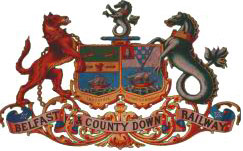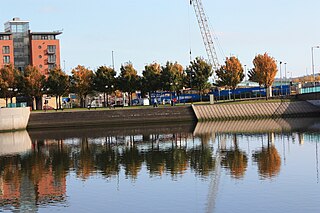Translink is the brand name of the Northern Ireland Transport Holding Company (NITHCo), a public corporation in Northern Ireland which provides the public transport in the region. NI Railways, Ulsterbus and Metro are all part of Translink. It is led by CEO Chris Conway.

The Ulster Transport Authority (UTA) ran rail and bus transport in Northern Ireland from 1948 until 1966.

The Belfast and County Down Railway (BCDR) was an Irish gauge railway in Ireland linking Belfast with County Down. It was built in the 19th century and absorbed into the Ulster Transport Authority in 1948. All but the line between Belfast and Bangor was closed in the 1950s, although some of it has been restored near Downpatrick by a heritage line, the Downpatrick and County Down Railway.

York Road railway station served the north of Belfast in Northern Ireland. It was formerly one of the three terminus railway stations in Belfast. The others were Great Victoria Street, and Queen's Quay.

Ballymacarrett or Ballymacarret is the name of both a townland and electoral ward in Belfast. The townland is in County Down and the electoral ward is part of the Titanic district electoral area of Belfast City Council.

Titanic Quarter railway station is located in the townland of Ballymacarrett in east Belfast. It is a short walk from the SSE Arena and Titanic Quarter.

Titanic Quarter in Belfast, Northern Ireland, is a large-scale waterfront regeneration, comprising historic maritime landmarks, film studios, education facilities, apartments, a riverside entertainment district, and the world's largest Titanic-themed attraction centred on land in Belfast Harbour, known until 1995 as Queen's Island. The 185-acre (75 ha) site, previously occupied by part of the Harland and Wolff shipyard, is named after the company's, and the city's, most famous product, RMS Titanic. Titanic Quarter is part of the Dublin-based group, Harcourt Developments, which has held the development rights since 2003.

The Lisburn–Antrim line is a 20-mile (32 km) railway line of Northern Ireland Railways. It links Knockmore Junction on the Belfast–Newry line with Antrim on the Belfast–Derry line. It has been closed to passenger services since 2003.
EWAY is a bus rapid transit route being built in Northern Ireland to link the town of Dundonald in County Down with Belfast City Centre. If completed it will be about 5.5 miles (9 km) long.
Transportation systems in the city of Belfast, Northern Ireland include road, air, rail, and sea. It is still a relatively car dependent city however it is also served by a comprehensive rail and bus network. Belfast also ran electric trams prior to 1954. The city has two major airports and the Port of Belfast is the busiest ferry port on the island of Ireland.

Queen's Quay is a section of the River Lagan, in the western Titanic Quarter of the city of Belfast, Northern Ireland.
Tillysburn railway station was a railway station on the Bangor line of the Belfast and County Down Railway. It opened in 1848, closed in 1945 and was located 2 miles 48 chains (4.2 km) from the Queens Quay terminus.
Neill's Hill railway station is a disused railway station / halt on the main line of the Belfast and County Down Railway. It ran from Queen's Quay, Belfast south to Newcastle, County Down in Northern Ireland.

Ballymacarrett railway station was a railway halt that served the townland of Ballymacarrett in east Belfast.

Queen's Quay railway station served the east of Belfast in Northern Ireland. It was formerly one of the three terminus railway stations in Belfast. The others were Great Victoria Street, and York Road.
The Ballymacarrett rail crash occurred on 10 January 1945 at 7:50am in the Ballymacarrett area of Belfast, County Down, Northern Ireland on the Belfast to Bangor Line of the Belfast and County Down Railway, when a train led by a heavy autotrain driving trailer ran into the back of a stopped passenger train consisting of lightweight wooden coaches. 22 died with 27 injured. It was the worst crash in Northern Ireland since 1889. The cause was found to be carelessness of the driver of the autotrain who was running too fast for conditions. Fog, unsafe railway rules, and possible distraction from passengers all may have contributed to the accident. Old lightweight rolling stock contributed to the great number of injuries and deaths. The accident led to the demise of the railway which was nationalised three years later.
Windsor railway station was on the Belfast Central Railway which ran from Ulster Junction on the Ulster Railway to Ballymacarrett Junction on the Belfast and County Down Railway, through central Belfast, Ireland.
Ormeau railway station was on the Belfast Central Railway which ran from the Ulster Junction on the Ulster Railway to Ballymacarrett Junction on the Belfast and County Down Railway, through central Belfast, Ireland.
Queen's Bridge railway station was the terminus of the Belfast Central Railway which ran from the Ulster Junction on the Ulster Railway to Ballymacarrett Junction on the Belfast and County Down Railway, through central Belfast, Ireland.
The Belfast Central Railway was a railway company operating in Belfast, Northern Ireland. The company was incorporated by Act of Parliament in 1872 and acquired by the Great Northern Railway (Ireland) in 1885.